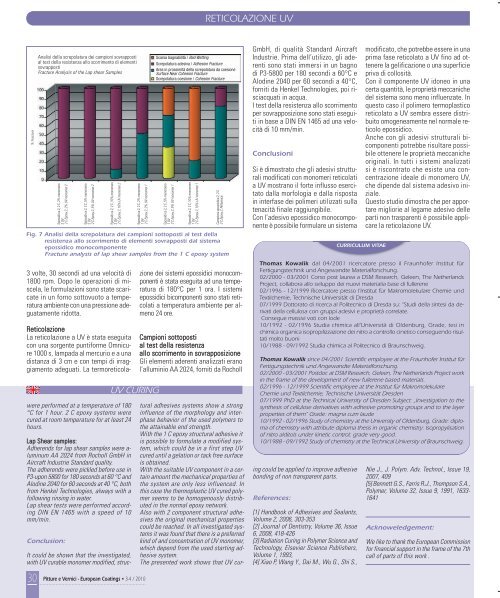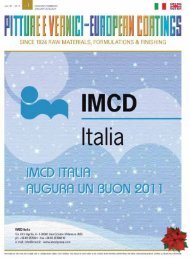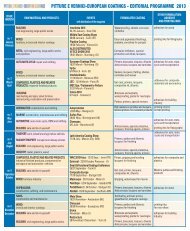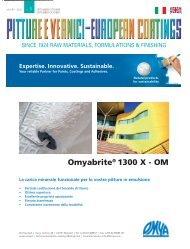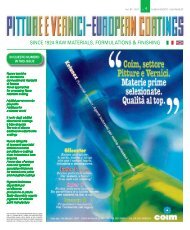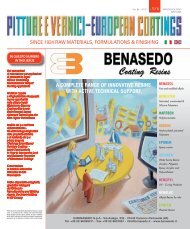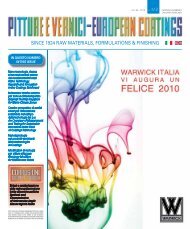Create successful ePaper yourself
Turn your PDF publications into a flip-book with our unique Google optimized e-Paper software.
% Fracture<br />
3 volte, 30 secondi ad una velocità di<br />
1800 rpm. Dopo le operazioni di miscela,<br />
le formulazioni sono state scaricate<br />
in un forno sottovuoto a temperatura<br />
ambiente con una pressione adeguatamente<br />
ridotta.<br />
Reticolazione<br />
La reticolazione a UV è stata eseguita<br />
con una sorgente puntiforme Omnicure<br />
1000 s, lampada al mercurio e a una<br />
distanza di 3 cm e con tempi di irraggiamento<br />
adeguati. La termoreticola-<br />
30<br />
Analisi della screpolatura dei campioni sovrapposti<br />
al test della resistenza allo scorrimento di elementi<br />
sovrapposti<br />
Fracture Analysis of the Lap shear Samples<br />
Epossidi ca 2, 2 C, 2% monomero<br />
2 UV<br />
2 C Epoxy 2, 2% UV monomer 2<br />
were performed at a temperature of 180<br />
°C for 1 hour. 2 C epoxy systems were<br />
cured at room temperature for at least 24<br />
hours.<br />
Lap Shear samples:<br />
Adherends for lap shear samples were aluminum<br />
AA 2024 from Rocholl GmbH in<br />
Aircraft Industrie Standard quality.<br />
The adherends were pickled before use in<br />
P3-upon 5800 for 180 seconds at 60 °C and<br />
Alodine 2040 for 60 seconds at 40 °C, both<br />
from Henkel Technologies, always with a<br />
following rinsing in water.<br />
Lap shear tests were performed according<br />
DIN EN 1465 with a speed of 10<br />
mm/min.<br />
Conclusion:<br />
Epossidi ca 2, 2 C, 5% monomero<br />
2 UV<br />
2 C Epoxy 2, 5% UV monomer 2<br />
Epossidi ca 2, 2 C, 10% monomero<br />
2 UV<br />
2 C Epoxy 2, 10% UV monomer 2<br />
It could be shown that the investigated,<br />
with UV curable monomer modified, struc-<br />
Epossidi ca 2, 2 C, 2% monomero<br />
1 UV<br />
2 C Epoxy 2, 2% UV monomer 1<br />
UV CURING<br />
Pitture e Vernici - European Coatings • 3-4 / <strong>2010</strong><br />
Scarsa bagnabilità / Bad Wetting<br />
Screpolatura adesiva / Adhesion Fracture<br />
Area in prossimità della screpolatura da coesione<br />
Surface Near Cohesion Fracture<br />
Screpolatura coesione / Cohesion Fracture<br />
Epossidi ca 2, 2 C, 5% monomero<br />
1 UV<br />
2 C Epoxy 2, 5% UV monomer 1<br />
Epossidi ca 2, 2 C, 10% monomero<br />
1 UV<br />
2 C Epoxy 2, 10% UV monomer 1<br />
Fig. 7 Analisi della screpolatura dei campioni sottoposti al test della<br />
resistenza allo scorrimento di elementi sovrapposti dal sistema<br />
epossidico monocomponente<br />
Fracture analysis of lap shear samples from the 1 C epoxy system<br />
zione dei sistemi epossidici monocomponenti<br />
è stata eseguita ad una temperatura<br />
di 180°C per 1 ora. I sistemi<br />
epossidici bicomponenti sono stati reticolati<br />
a temperatura ambiente per almeno<br />
24 ore.<br />
Campioni sottoposti<br />
al test della resistenza<br />
allo scorrimento in sovrapposizione<br />
Gli elementi aderenti analizzati erano<br />
l’alluminio AA 2024, forniti da Rocholl<br />
tural adhesives systems show a strong<br />
influence of the morphology and interphase<br />
behavior of the used polymers to<br />
the attainable end strength.<br />
With the 1 C epoxy structural adhesive it<br />
is possible to formulate a modified system,<br />
which could be in a first step UV<br />
cured until a gelation or tack free surface<br />
is obtained.<br />
With the suitable UV component in a certain<br />
amount the mechanical properties of<br />
the system are only less influenced. In<br />
this case the thermoplastic UV cured polymer<br />
seems to be homogenously distributed<br />
in the normal epoxy network.<br />
Also with 2 component structural adhesives<br />
the original mechanical properties<br />
could be reached. In all investigated systems<br />
it was found that there is a preferred<br />
kind of and concentration of UV monomer,<br />
which depend from the used starting adhesive<br />
system.<br />
The presented work shows that UV cur-<br />
RETICOLAZIONE UV<br />
Campione epossidica 2, 2 C<br />
2 C Epoxy 2, Reference<br />
GmbH, di qualità Standard Aircraft<br />
Industrie. Prima dell’utilizzo, gli aderenti<br />
sono stati immersi in un bagno<br />
di P3-5800 per 180 secondi a 60°C e<br />
Alodine 2040 per 60 secondi a 40°C,<br />
forniti da Henkel Technologies, poi risciacquati<br />
in acqua.<br />
I test della resistenza allo scorrimento<br />
per sovrapposizione sono stati eseguiti<br />
in base a DIN EN 1465 ad una velocità<br />
di 10 mm/min.<br />
Conclusioni<br />
Si è dimostrato che gli adesivi strutturali<br />
modificati con monomeri reticolati<br />
a UV mostrano il forte influsso esercitato<br />
dalla morfologia e dalla risposta<br />
in interfase dei polimeri utilizzati sulla<br />
tenacità finale raggiungibile.<br />
Con l’adesivo epossidico monocomponente<br />
è possibile formulare un sistema<br />
ing could be applied to improve adhesive<br />
bonding of non transparent parts.<br />
References:<br />
[1] Handbook of Adhesives and Sealants,<br />
Volume 2, 2006, 303-353<br />
[2] Journal of Dentistry, Volume 36, Issue<br />
6, 2008, 418-426<br />
[3] Radiation Curing in Polymer Science and<br />
Technology, Elsevier Science Publishers,<br />
Volume 1, 1993,<br />
[4] Xiao P, Wang Y., Dai M., Wu G., Shi S.,<br />
CURRICULUM VITAE<br />
modificato, che potrebbe essere in una<br />
prima fase reticolato a UV fino ad ottenere<br />
la gelificazione o una superficie<br />
priva di collosità.<br />
Con il componente UV idoneo in una<br />
certa quantità, le proprietà meccaniche<br />
del sistema sono meno influenzate. In<br />
questo caso il polimero termoplastico<br />
reticolato a UV sembra essere distribuito<br />
omogeneamente nel normale reticolo<br />
epossidico.<br />
Anche con gli adesivi strutturali bicomponenti<br />
potrebbe risultare possibile<br />
ottenere le proprietà meccaniche<br />
originali. In tutti i sistemi analizzati<br />
si è riscontrato che esiste una concentrazione<br />
ideale di monomero UV,<br />
che dipende dal sistema adesivo iniziale.<br />
Questo studio dimostra che per apportare<br />
migliorie al legame adesivo delle<br />
parti non trasparenti è possibile applicare<br />
la reticolazione UV.<br />
Thomas Kowalik dal 04/2001 ricercatore presso il Fraunhofer Institut für<br />
Fertigungstechnik und Angewandte Materialforschung.<br />
02/2000 - 03/2001 Corso post laurea a DSM Research, Geleen, The Netherlands<br />
Project, collabora allo sviluppo dei nuovi materialia base di fullerene<br />
02/1996 - 12/1999 Ricercatore presso l’Institut für Makromolekulare Chemie und<br />
Textilchemie, Technische Universität di Dresda<br />
07/1999 Dottorato di ricerca al Politecnico di Dresda su: “Studi della sintesi da derivati<br />
della cellulosa con gruppi adesivi e proprietà correlate.<br />
Consegue massivi voti con lode<br />
10/1992 - 02/1996 Studia chimica all’Università di Oldenburg, Grade, tesi in<br />
chimica organica isopropilizzazione dei nitro a controllo cinetico conseguendo risultati<br />
molto buoni<br />
10/1988 - 09/1992 Studia chimica al Politecnico di Braunschweig.<br />
Thomas Kowalik since 04/2001 Scientific employee at the Fraunhofer Institut für<br />
Fertigungstechnik und Angewandte Materialforschung.<br />
02/2000 - 03/2001 Postdoc at DSM Research, Geleen, The Netherlands Project work<br />
in the frame of the development of new fullerene based materials.<br />
02/1996 - 12/1999 Scientific employee at the Institut für Makromolekulare<br />
Chemie und Textilchemie, Technische Universität Dresden<br />
07/1999 PhD at the Technical University of Dresden Subject: „Investigation to the<br />
synthesis of cellulose derivatives with adhesive promoting groups and to the layer<br />
properties of them“ Grade: magna cum laude<br />
10/1992 - 02/1996 Study of chemistry at the University of Oldenburg, Grade: diploma<br />
of chemistry with attribute diploma thesis in organic chemistry: Isopropylisation<br />
of nitro alditols under kinetic control; grade very good.<br />
10/1988 - 09/1992 Study of chemistry at the Technical University of Braunschweig.<br />
Nie J., J. Polym. Adv. Technol., Issue 19,<br />
2007, 409<br />
[5] Bennett G.S., Farris R.J., Thompson S.A.,<br />
Polymer, Volume 32, Issue 9, 1991, 1633-<br />
1641<br />
Acknoweledgement:<br />
We like to thank the European Commission<br />
for financial support in the frame of the 7th<br />
call of parts of this work .


